
Introduction
Have you ever bought a highly-rated curly hair product only to find it leaves your hair greasy, crunchy, or just plain frizzy? The secret to unlocking your best curls isn’t about finding a single “magic” product; it’s about understanding what your hair truly needs. This is where knowing your specific curly hair type becomes a game-changer. From loose waves to tight coils, every curl pattern is unique and requires a personalized approach to thrive.
This comprehensive guide will help you identify your hair type, understand its specific needs, and build a curly hair care routine that brings out the best in your natural texture. We’ll explore everything from the famous curly hair chart to the best curly hair products for your strands. Beyond just your curl shape, we will also touch on how factors like hair texture (fine, medium, coarse) and porosity (how well your hair absorbs moisture) play a crucial role in your hair’s health. Get ready to finally understand, embrace, and love the hair you were born with.

Why Identifying Your Curl Type Matters
Understanding your curl pattern is the first step toward ending the frustrating cycle of trial and error with hair care. When you know whether you have waves, curls, or coils, you can make informed decisions that lead to healthier, more defined, and manageable hair.
Knowing your specific curly hair type directly impacts your product choices. For instance, a heavy cream that works wonders for dense, coily hair will likely weigh down fine, wavy hair, leaving it limp and lifeless. Conversely, a lightweight mousse designed for waves may not provide enough moisture or hold for tight, springy curls.
Beyond product selection, a tailored routine helps you combat common issues more effectively. Proper care for your specific type of curly hair is essential for frizz control and preventing breakage. Curls are naturally more fragile than straight hair because the scalp’s natural oils have a harder time traveling down the twists and turns of the hair shaft. This leads to dryness, which in turn causes frizz and makes the hair susceptible to damage. By identifying your curl type, you can implement a natural curly hair routine focused on providing the right level of moisture retention, which is key to keeping your curls happy and healthy.
Understanding Curl Classification (The Andre Walker System)
The most widely recognized method for classifying hair is the Andre Walker Hair Typing System. Originally created by Oprah Winfrey’s stylist, this system categorizes hair into four main types, with three subcategories each that describe the tightness or width of the pattern.
- Type 1: Straight Hair
- Type 2: Wavy Hair
- Type 3: Curly Hair
- Type 4: Coily Hair
For those with textured hair, we focus on Types 2, 3, and 4. The letters (A, B, C) represent the diameter of the curl. ‘A’ types have the widest pattern, ‘B’ is in the middle, and ‘C’ has the tightest and smallest pattern within its category. It’s also very common to have multiple curl patterns on one head of hair. You might have Type 3A curls at the crown and 3B curls underneath, for example. This curly hair chart is a starting point, not a strict rule.
Let’s break down the types of curly hair.
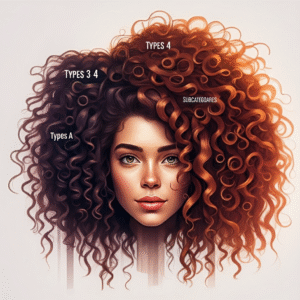
Wavy Hair (Type 2)
Wavy hair forms a distinct ‘S’ shape and sits somewhere between straight and curly. This hair type can be prone to frizz and often needs a little encouragement to reach its full wave potential. The key is using lightweight products that won’t weigh the hair down.
Type 2A Hair
Type 2A hair features a very loose, gentle “S” pattern, often described as “beachy waves.” The hair tends to be fine and lies flatter at the root. It can be easily straightened or weighed down by heavy products.
- Care Tips: Focus on volume and texture. Use lightweight mousses and sea salt sprays to enhance your natural wave without making it greasy. A gentle, sulfate-free shampoo is essential. Avoid heavy creams and oils.
- Challenges: Lack of volume at the roots and waves that fall flat easily.
Type 2B Hair
Type 2B hair has a more defined S-shape that starts around the mid-lengths. It’s more prone to frizz than 2A, especially in humid weather. The texture is typically medium, and the hair isn’t as easy to straighten.
- Care Tips: Your routine should focus on frizz control and definition. A light gel or mousse can help hold the wave pattern. Try scrunching your hair when wet to encourage curl clumping.
- Challenges: Frizz is the main enemy here. The roots can still be relatively straight, while the ends are wavy.
Type 2C Hair
Type 2C hair consists of thick, well-defined ‘S’ waves that start right from the root. Some strands might even form loose spiral curls. This hair type is coarse and highly susceptible to frizz.
- Care Tips: Moisture retention is important, but you still want to avoid overly heavy products. Layer a leave-in conditioner under a stronger hold gel. Consider co-washing curly hair (washing with only conditioner) a few times a week to maintain hydration.
- Challenges: Can be difficult to style and is often very frizzy if not properly moisturized.
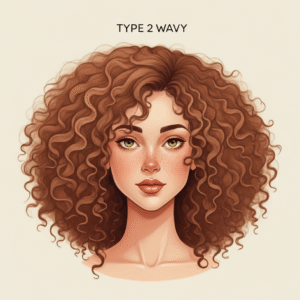
Curly Hair (Type 3)
Type 3 hair is what most people picture when they think of “curly.” These curls are well-defined, springy, and form spirals or ringlets. Hydration is the most critical element for this hair type to prevent dryness and frizz.
Type 3A Hair
Type 3A hair features large, loose curls with a shiny, smooth texture. The curls have a circumference about the size of a piece of sidewalk chalk. They are well-defined but can lose that definition if not cared for properly.
- Care Tips: Use curl creams to define your pattern without weighing it down. Apply products to soaking wet hair to lock in moisture and prevent frizz. Avoid brushing your hair when it’s dry.
- Challenges: Frizz and loss of curl definition throughout the day.
Type 3B Hair
Type 3B hair has bouncy, springy curls that are about the width of a Sharpie marker. This hair type has more volume than 3A but is also more prone to dryness and frizz.
- Care Tips: A good curly hair care routine for 3B hair involves layering moisturizing products. Start with a leave-in conditioner, followed by a curl cream for hydration and a gel for hold. Deep conditioning treatments are a must.
- Challenges: Dryness is a major concern. The curls can shrink significantly as they dry.
Type 3C Hair
Type 3C hair consists of tight, densely packed corkscrew curls, similar in size to a pencil or straw. This type has incredible volume but is also very prone to dryness and shrinkage. It’s sometimes referred to as a “coily-curly” texture.
- Care Tips: This is where co-washing curly hair becomes very beneficial. Use rich, creamy styling products. The “LOC” method (Leave-in, Oil, Cream) can work wonders for locking in moisture.
- Challenges: Extreme dryness, shrinkage, and tangles due to the density of the curls.
Coily/Kinky Hair (Type 4)
Type 4 hair is the most delicate of the curl types. It’s characterized by tightly packed coils or a ‘Z’ shaped pattern. Coily hair is often very dry and fragile, making moisture retention the absolute top priority. Shrinkage is also a significant factor, as the hair can appear much shorter than its actual length.
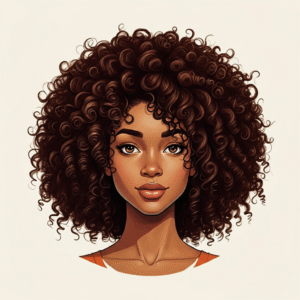
Type 4A Hair
Type 4A hair has dense, springy coils with a visible ‘S’ pattern, about the size of a crochet needle. The coils are well-defined but are also fragile and prone to dryness.
- Care Tips: Use rich creams, butters, and oils to keep the hair moisturized. A natural curly hair routine for 4A often includes wash-and-go styles using a strong-hold gel over a moisturizing leave-in.
- Challenges: Dryness and breakage. Requires a consistent moisturizing routine.
Type 4B Hair
Type 4B hair has a ‘Z’ shaped pattern with sharp angles, rather than a defined coil. The strands are very densely packed. This hair type is extremely delicate and prone to breakage.
- Care Tips: Protective styles like twists, braids, and buns are excellent for minimizing manipulation and protecting the ends. When styling, use plenty of product with slip to avoid snagging. Palm-rolling or shingling can help define the pattern.
- Challenges: Extreme dryness and high potential for breakage. Shrinkage can be up to 75%.
Type 4C Hair
Similar to 4B, Type 4C hair has a zig-zag pattern but is even more tightly coiled and experiences the most shrinkage. The curl pattern may not be visible without styling techniques like twisting or shingling. It is the most fragile of all hair types.
- Care Tips: The focus is entirely on protection and moisture. Use heavy butters and oils like shea butter and castor oil. Deep conditioning treatments, often with heat, are essential. Low-manipulation and protective styles are crucial for length retention.
- Challenges: Extreme shrinkage, dryness, and fragility. It requires a lot of patience and gentle care.
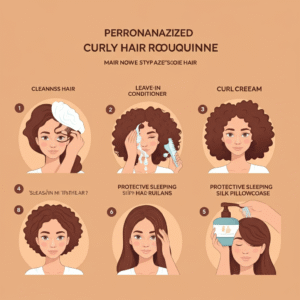
Creating a Personalized Curly Hair Routine
Now that you have a better idea of your curly hair type, you can build a routine that works for you. Here is a step-by-step guide to a foundational curly hair care routine.
- Cleansing (Co-Wash or Sulfate-Free Shampoo): How often you wash depends on your hair type. Oiler, wavier types may need to wash 2-4 times a week, while drier, coily types might only wash once a week. Always use a sulfate-free shampoo to avoid stripping your hair of its natural oils. For very dry types (3C-4C), consider replacing some shampoo days with co-washing, which is washing your hair with a cleansing conditioner.
- Conditioning: This is a non-negotiable step for all curl types. After cleansing, apply a generous amount of conditioner. Use your fingers or a wide-tooth comb to gently detangle your hair while it’s saturated with conditioner. Never try to detangle curly hair when it’s dry. For extra dry hair, leave the conditioner on for a few minutes before rinsing.
- Deep Conditioning: Once a week, swap your regular conditioner for a deep conditioner or hair mask. This treatment provides an intense dose of moisture that helps prevent breakage and improve elasticity. For Type 4 hair, adding gentle heat with a shower cap or hooded dryer can help the product penetrate more deeply.
- Styling (Leave-in, Cream, Gel): The best time to apply styling products is when your hair is soaking wet. This helps lock in moisture and define your curl pattern without frizz.
-
- Leave-in Conditioner: A light layer provides a base of moisture.
- Curl Cream: Adds further hydration and helps clump curls together.
- Gel or Mousse: Provides hold and creates a “cast” that locks in your curl shape and prevents frizz. Once your hair is fully dry, you can gently “scrunch out the crunch” to reveal soft, defined curls.
- Drying: Avoid rough terrycloth towels, which cause frizz. Instead, use a microfiber towel or an old t-shirt to gently scrunch out excess water. You can then either air-dry or use a diffuser on low heat and low speed. A diffuser helps dry your curls without disturbing their pattern.
- Protective Sleeping: To protect your curls overnight, try the “pineapple” method—gathering your hair in a loose, high ponytail on top of your head. Sleeping on a silk or satin pillowcase reduces friction, which helps prevent tangles and frizz.
Common Mistakes in Curly Hair Care
Are you making one of these common mistakes? Avoiding them can dramatically improve the health of your curls.
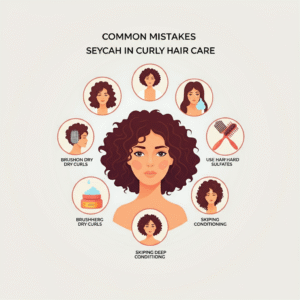
- Brushing Dry Curls: This is the number one cause of frizz and breakage. It disrupts your curl pattern and can lead to a frizzy mess. Only detangle your hair when it’s wet and coated with conditioner.
- Using Harsh Sulfates: Sulfates are strong detergents found in many shampoos that strip the hair of its natural moisture. For curly hair that is already prone to dryness, this is a major problem.
- Skipping Deep Conditioning: A regular conditioner is for daily maintenance, but a deep conditioner is for intensive repair and hydration. Skipping this crucial step can leave your hair brittle and lifeless.
- Applying Products to Damp or Dry Hair: Styling products work best on soaking wet hair. Applying them to damp hair can result in uneven application and frizz.
- Overusing Heat: Excessive heat from flat irons, curling wands, and high-heat blow-drying can cause irreversible damage to your curl pattern. If you must use heat, always use a heat protectant.
- Using Cotton Towels: The rough texture of cotton towels creates friction that ruffles the hair cuticle, leading to frizz. Stick to microfiber towels or t-shirts.
Recommended Products for Each Curl Type
Finding the right curly hair products is a journey, but here are some general recommendations to get you started.
For Wavy Hair (Type 2)
- Shampoo: Lightweight, sulfate-free volumizing shampoo.
- Conditioner: Lightweight conditioner that won’t weigh hair down. Focus application on the ends.
- Stylers: Mousse, light gel, or sea salt spray to enhance texture.
For Curly Hair (Type 3)
- Shampoo/Co-wash: Moisturizing sulfate-free shampoo or a cleansing conditioner.
- Conditioner: A rich, hydrating conditioner with lots of slip for detangling.
- Stylers: Layering is key. Use a leave-in conditioner, a curl cream for moisture, and a medium-to-strong hold gel for definition.
For Coily Hair (Type 4)
- Shampoo/Co-wash: A rich co-wash or a very gentle, creamy moisturizing shampoo.
- Conditioner: A thick, buttery deep conditioner or treatment mask.
- Stylers: Heavy creams, butters (like shea or mango), and oils (like castor or jojoba) are your best friends. The LOC (Leave-in, Oil, Cream) or LCO (Leave-in, Cream, Oil) methods are perfect for sealing in moisture.
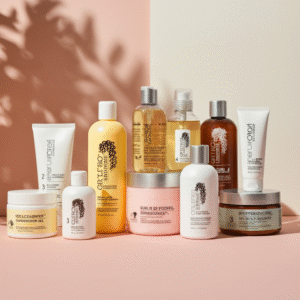
Conclusion
Embracing your natural hair is a journey of discovery and self-love. Understanding your unique curly hair type is the most powerful tool you have to end the struggle with frizz, dryness, and damage. By learning about your specific curl pattern, you can create a personalized curly hair care routine that gives your hair exactly what it needs to be healthy, defined, and beautiful.
Stop fighting your hair and start working with it. Use this guide to identify your curls, build a routine filled with the right curly hair products and techniques, and watch your hair transform. Your perfect curls are waiting—all you have to do is give them the care they deserve.





Leave a Reply